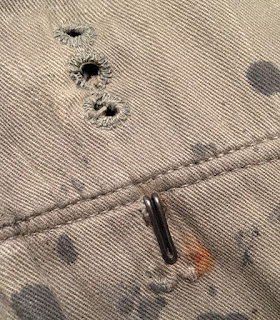This material is translated from the 1943 edition of the Wehrmacht manual "Hilfsbuch für den Hauptfeldwebel" by Hans Rödel.
Instruction Sheet Regarding Care and Upkeep of Clothing and Equipment Items
1. Means for individual cleaning and maintenance of clothing and equipment
Enlisted men are to obtain by their own means the following commercially available goods, and to constantly keep them in usable condition:
1 large clothing brush (Kleiderbürste), 1 stiff brush for removing dirt (Schmutzbürste), 2 small brushes (Auftragsbürste), 1 polishing brush (Blankbürste), 1 bristle brush (Borstenbürste), 1 clothes whip (Klopfpeitsche).
Shoe cream or shoe polish, leather fat, curd soap (Kernseife).
1 pair scissors, sewing and darning needles, darning yarn, black white and gray thread, various buttons.
2. Cleaning and Maintenance of individual uniform and equipment pieces
I. General
The soldier is obligated to keep the uniform and equipment items in his possession well and carefully maintained. The soldier himself has to care for the cleaning of his underclothing and must pay for the cleaning costs out of his own income. The cleaning of the remaining items issued to the soldier for his use is also his responsibility, insofar as he can clean them with water, soap, etc. - or if need be, with a soft brush.
All items must be kept constantly maintained. Every soldier must himself perform small repairs on the uniform and equipment items he was issued, as long as these do not require specialized craftsmanship knowledge to be repaired, for example replacing buttons, replacing hooks and eyes, sewing split seams. The necessary supplies must be provided through his own means. Larger maintenance tasks are to be given to the Bekleidungsoffizier promptly, meaning when the damage first happens.
II. Cleaning of uniform pieces
Underclothes: Underclothes and sports shirts should soak in cold soapy water for a long time, at least overnight. A brush may not be used for the cleaning of underclothing and sports shirts. Sports shorts and swim trunks, collar binds, helmet bands and arm bands are not to be boiled, rather just washed by hand in warm soapy water (without a brush) and then rinsed.
Knit wool items: All knit wool items should be washed in lukewarm water or soapy water. Boiling or the use of hot water or brushes is forbidden, this causes the wool to become matted.
Wool uniform items: Wool uniforms should whenever possible not be washed. They are cleaned by brushing and by beating with a clothing whip. The use of wire brushes is forbidden. Stains can be removed with gasoline or diluted Salmiak (ammonium chloride). The Exerziergarnitur (uniform for field use) may be cleaned with a short-trimmed bristle brush and soap in places that are heavily soiled.
HBT uniform items: HBT uniforms can be cleaned with a bristle brush and soap in hot water, but long boiling is to be avoided.
Bread bag: The bread bag is to be cleaned with a soft brush, warm water and Kernseife (curd soap). Drying the bread bag near an oven is to be avoided, as this makes the leather straps brittle.
III. Care of footwear
Leather uppers that are poorly cared for, or that have been improperly cared for with inferior, poorly-suited care products, become hard and brittle. Hard upper leather is in most cases the root cause of the formation of hard creases and foot damage. The soldier is obligated to keep the footwear items in his possession well and carefully maintained.
Greasing: The leather of footwear must be kept soft. It is necessary to treat the upper leather at least once a week with acid free leather oil or leather fat. Before doing this, dirt and any remaining traces of polishing product must be removed by washing with lukewarm water. Excessive use of grease should be avoided, otherwise the product will soak through, soil the interior of the footwear, and also, in warm weather, lead to burning, formation of blisters or sores on the feet.
Cleaning: The use of shoe polish on the foot part is to be limited to the smallest amount possible. Polishing work may only be done with a brush or cloths. Use of other products and the working of a "high gloss" finish on the foot part, are forbidden. A very light dusting of grease on the foot part during the daily cleaning results in a soft, march-ready boot. Wet-washing or rinsing of the interior leads to disintegration of the sole and with that, foot damages.
Treatment: Drying wet footwear in the vicinity of a heated stove, a radiator, etc. is forbidden. They should be stuffed with paper or straw and as much as possible aired out or put in a slightly warm place to dry. Before doing this, no product should be applied to the footwear. Wet footwear is not to be stretched out on chair legs, etc., as this deforms the wet leather at the rear seams. The boots can be put on by helping each other by hand, or with a boot jack. Bed and table parts, etc. may not be used for this, as it puts pressure on the caps of the heels. By stepping on the tip of the foot, it puts pressure on the upper leather and brings about rubbing on the toes.
IV. Miscellaneous
Overcoat: The rolled overcoat must immediately be unrolled upon return.
Mess kit, canteen and drinking cup: Never store the canteen for a long time. When cleaning, abrasive products like wire brushes, metal polishing cloths, sand, etc. are not to be used. The simplest materials are water and brushes. After cleaning, it is good to rinse with water that is as hot as possible, and wipe completely dry. Mess kits and canteens are not to be kept closed with moisture inside. With use, the inside of the mess kit will develop a yellow-brown to gray-black visible coating (oxidation layer), that has no effect on the taste, the appearance or the quality of food. It protects against being worn out and may not be removed.

















































